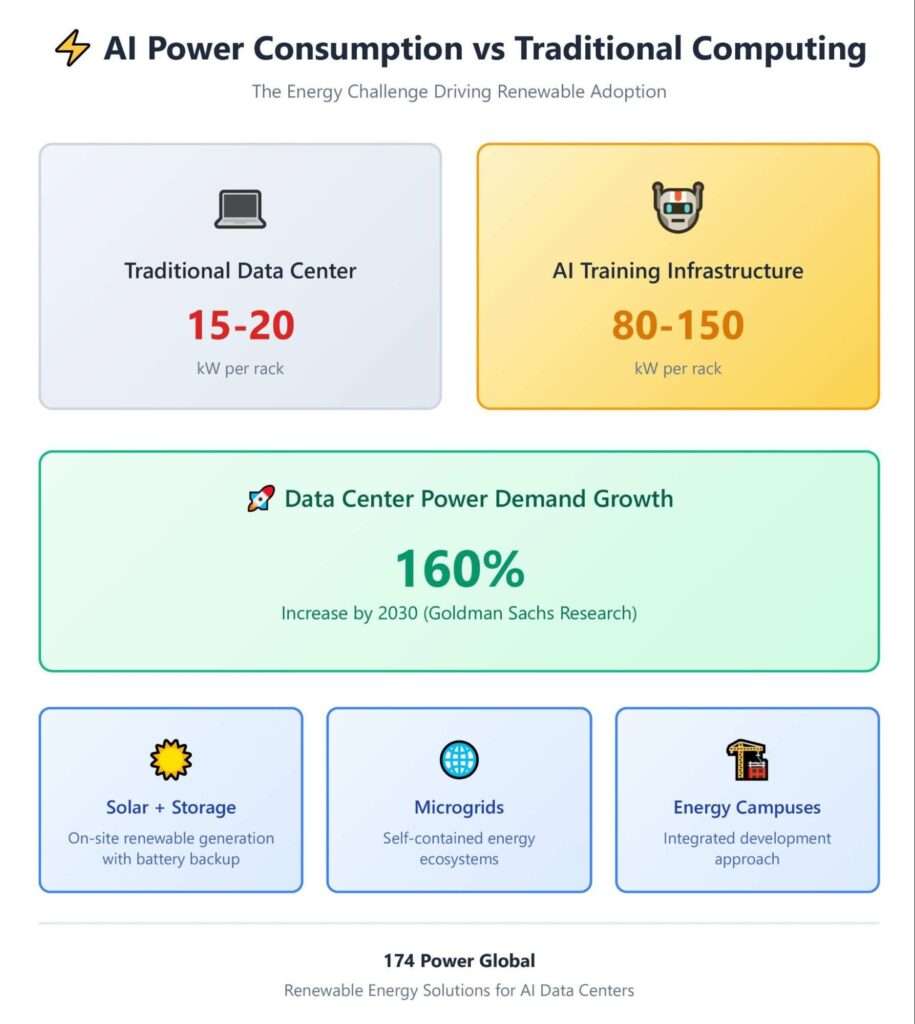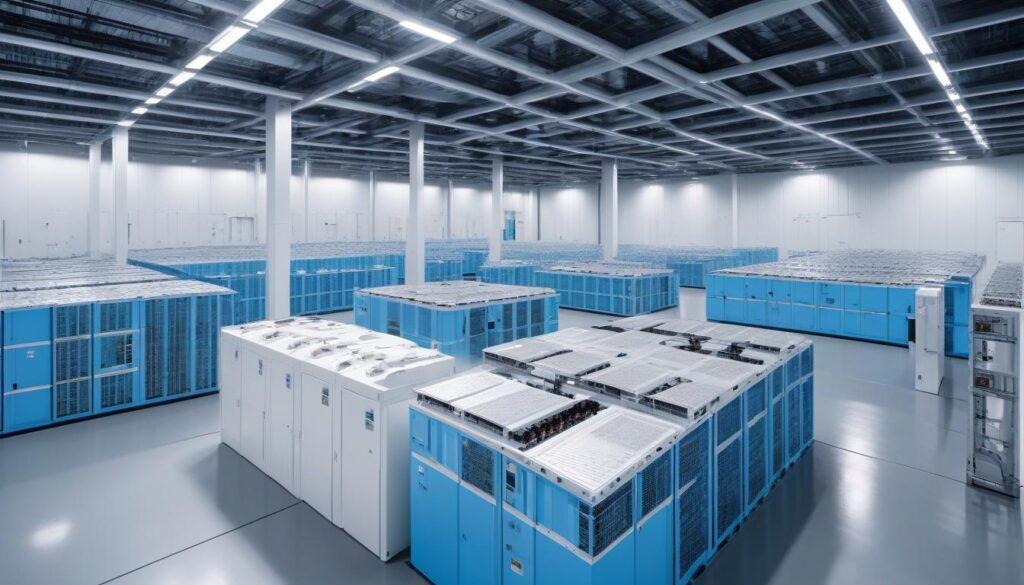Bottom Line
Renewable energy has become the cornerstone of sustainable AI data center development as artificial intelligence drives unprecedented power consumption growth that traditional grid infrastructure cannot support.
- Data center power demand will grow 160% by 2030, requiring innovative renewable integration strategies to meet AI workloads that consume 3-5 times more energy than traditional computing
- Major tech companies are investing billions in renewable partnerships, with Google’s “power first” approach and Microsoft’s massive renewable commitments leading industry transformation toward clean energy
- Grid constraints and intermittency challenges demand hybrid solutions combining solar, wind, energy storage, and strategic geographic distribution to ensure 24/7 reliability for mission-critical AI operations
- Energy campus development integrating renewable generation with data center infrastructure represents the most viable path forward for scalable, sustainable AI operations that can operate independently of constrained utility grids
The organizations that successfully integrate renewable energy strategies from the ground up will gain decisive competitive advantages in both operational costs and carbon compliance as AI adoption accelerates.
Artificial intelligence has triggered an energy revolution in data center operations. As AI workloads demand exponentially more computational power, the digital infrastructure supporting these systems faces unprecedented energy challenges that traditional grid-based approaches simply cannot address sustainably.
The numbers tell a compelling story. According to Goldman Sachs Research, data center power demand will surge 160% by 2030, with AI operations accounting for a significant portion of this growth. This explosive growth has made renewable energy for AI data centers not just an environmental priority, but a business imperative for organizations seeking reliable, scalable, and cost-effective power solutions.
The Unprecedented Energy Appetite of AI Infrastructure
AI data centers operate fundamentally differently from traditional computing facilities. Where conventional data centers might handle cyclical workloads with predictable peak and valley periods, AI operations—particularly those involved in model training and real-time inference—demand sustained, high-intensity power consumption that rarely fluctuates downward.
The hardware driving this demand tells the story clearly. Modern AI training requires massive GPU clusters, with individual racks consuming 80-150 kW compared to 15-20 kW for traditional enterprise servers. A single ChatGPT query requires 2.9 watt-hours of electricity, nearly ten times more than a standard Google search. These intensive computational requirements, multiplied across millions of daily interactions, create energy demands that challenge both traditional power infrastructure and conventional approaches to data center design.

The scale becomes even more dramatic when examining training operations for large language models. Modern AI model training requires thousands of specialized processors running continuously for extended periods, consuming massive amounts of electricity. As AI models grow in complexity and capability, these energy requirements will only intensify, making sustainable ai data centers essential for the industry’s long-term viability.
Understanding the Grid Infrastructure Challenge
The traditional electrical grid was never designed to handle the rapid deployment and massive energy requirements of modern AI infrastructure. Utilities across key data center markets are struggling to keep pace with demand, creating bottlenecks that threaten the expansion of AI capabilities.
In Northern Virginia, often called the data capital of the world, available data center power has become extremely scarce. New facilities face extended wait times for adequate grid connections, with some utilities requiring complete transmission infrastructure upgrades before they can support additional large-scale operations. Similar constraints exist in other major markets, including Silicon Valley, Dublin, and emerging hubs in Texas and the Southeast.
The challenge extends beyond simple capacity limitations.Legacy grid infrastructure lacks the flexibility and redundancy required for AI workloads that cannot tolerate interruptions, making dedicated renewable energy for ai data centers a critical infrastructure requirement. Traditional backup generators, typically designed for short-term emergency use, are inadequate for facilities that may need to operate independently for extended periods during grid maintenance or severe weather events.
Corporate Leadership in Renewable AI Energy
Major technology companies have emerged as the largest corporate purchasers of renewable energy globally, driven both by sustainability commitments and the practical need for reliable, scalable power sources. Their approaches are creating new models for renewable energy integration that the broader industry is beginning to adopt.
Google’s recent partnership with Intersect Power and TPG Rise Climate represents a fundamental shift toward what the company calls a “power first” approach to data center development. Rather than building facilities and then seeking power connections, this strategy co-locates gigawatts of data center capacity with purpose-built renewable generation, ensuring that new AI infrastructure comes online alongside its own clean power supply.
Microsoft has made significant commitments to renewable energy procurement through partnerships with major energy developers, targeting massive clean energy capacity to power their expanding data center operations through 2030.
Amazon has emerged as one of the largest corporate purchasers of renewable energy globally, with operations spanning over 30 TWh of clean energy across their facilities and a target of achieving 100% renewable power in the coming years. Their approach combines long-term power purchase agreements with strategic investments in energy storage and grid modernization projects that benefit entire regions.
Innovation in How to Integrate Various Renewable Technologies
The intermittent nature of solar and wind generation has historically been viewed as incompatible with the 24/7 reliability requirements of data center operations, creating unique engineering challenges for renewable energy for ai data centers. However, advances in energy storage, grid management, and hybrid generation systems are rapidly changing this equation.
Large-scale battery energy storage systems (BESS) now provide the bridge between renewable generation and constant AI workloads, enabling reliable renewable ai power delivery even during extended low-generation periods. Modern lithium-ion installations can store excess renewable energy generated during peak production hours and release it during periods of high demand or low generation. Tesla’s Megapack systems, for example, can provide grid-scale storage capable of supporting data centers through extended periods without renewable generation.

Hybrid renewable systems combine multiple generation sources to improve reliability and capacity factors. Solar installations paired with wind power can provide more consistent energy profiles, as wind generation often peaks during evening hours when solar production declines. Advanced energy management systems optimize these combinations in real-time, automatically shifting between sources based on availability and demand patterns.
Microgrids represent the next evolution in renewable integration, creating self-contained energy ecosystems that can operate independently when needed. These systems combine on-site renewable generation, energy storage, and intelligent control systems that can island from the main grid during outages while maintaining full operational capability. Advanced cooling and energy management within these microgrids can reduce overall energy consumption by 20-30% compared to traditional grid-dependent facilities.
Geographic Distribution and Strategic Site Selection
The pursuit of renewable energy is driving geographic diversification in data center development, as operators seek locations with abundant clean energy resources rather than proximity to traditional telecommunications hubs. This shift is creating new opportunities in regions previously overlooked for large-scale digital infrastructure.
Texas has emerged as a leading destination due to its abundant wind and solar resources, coupled with a deregulated electricity market that enables direct renewable procurement. The state’s ERCOT grid, while facing its own challenges, offers flexibility for data center operators to implement innovative energy strategies, including direct interconnection with renewable generators.
The Pacific Northwest continues to attract AI infrastructure development due to its hydroelectric resources and moderate climate, which reduces cooling requirements. However, transmission constraints and environmental permitting challenges have limited expansion opportunities in some areas.
Emerging markets in the Southeast, including Georgia, North Carolina, and South Carolina, are developing renewable-friendly policies specifically designed to attract data center investment. These regions offer combinations of solar potential, favorable regulatory environments, and proximity to major population centers that make them attractive for sustainable ai data centers development.
International expansion is also driven by renewable energy availability. Ireland, despite its small size, hosts major data center operations due to its wind resources and favorable regulatory environment. However, grid capacity concerns have led to temporary moratoria on new developments, highlighting the need for proactive infrastructure planning.
The Role of Energy Storage in AI Operations
Energy storage has evolved from a supplementary technology to a core component of AI data center infrastructure. The requirements for AI workloads—sustained high power consumption with zero tolerance for interruptions—align perfectly with the capabilities of modern storage systems.
Battery storage provides multiple benefits beyond renewable integration. Grid-scale systems can provide frequency regulation services, helping utilities maintain stable power quality while generating additional revenue streams for data center operators. They also enable peak shaving, reducing demand charges by storing energy during off-peak hours and discharging during expensive peak periods.
Advanced storage technologies are expanding beyond traditional lithium-ion systems. Flow batteries offer longer duration storage for multi-day grid independence, while compressed air energy storage (CAES) provides massive scale storage capabilities for facilities requiring extended backup power. Some operators are experimenting with green hydrogen production and fuel cells as long-term storage solutions that can provide both electricity and process heat for facility operations.
The integration of storage with AI workload management represents a frontier in optimization. Machine learning algorithms can predict energy demand patterns and automatically adjust storage charging and discharging to minimize costs while maintaining reliability. These systems can also participate in grid services markets, providing ancillary services that help offset infrastructure costs.
Policy Framework and Regulatory Drivers
Government policies at federal, state, and local levels are increasingly shaping the renewable energy landscape for AI data centers. These regulations create both opportunities and requirements that influence site selection, technology choices, and operational strategies.
Federal incentives, including the Investment Tax Credit (ITC) and Production Tax Credit (PTC), significantly improve the economics of renewable energy projects. Recent policy expansions have extended these credits and added bonus incentives for projects that meet domestic content requirements or are located in energy communities, making co-located renewable generation more attractive for data center development.
State-level policies vary significantly but are increasingly focusing on data center energy consumption. According to Climate Solutions Legal Digest, New York’s proposed Sustainable Data Centers Act would require facilities to power operations with enough renewable energy to align with the state’s 70% renewable target by 2030. Michigan has implemented requirements that new data centers procure clean energy equivalent to 90% of their forecasted electricity usage.
Virginia, home to the largest concentration of data centers in the world, has seen numerous legislative proposals tying tax exemptions to energy efficiency and renewable energy standards. While most have been deferred, they signal growing political attention to the environmental impact of data center growth.
Carbon pricing mechanisms, while not yet widespread in the United States, are being implemented in various forms at state and regional levels, creating economic incentives to reduce AI energy usage through clean power adoption. The Regional Greenhouse Gas Initiative (RGGI) in the Northeast creates compliance costs for fossil fuel generation that improve the economic competitiveness of renewable energy for data center operations.
Future Trends and Emerging Technologies
The renewable energy landscape for AI data centers continues to evolve rapidly, with several emerging trends shaping the next generation of infrastructure development. Understanding these trends is crucial for organizations planning long-term AI strategies.
Green hydrogen is gaining attention as a clean fuel source for backup generation and long-term energy storage. Produced using excess renewable electricity, hydrogen can be stored indefinitely and converted back to electricity using fuel cells during periods of high demand or low renewable generation. Some forward-thinking developers are already integrating hydrogen production into their energy campuses, creating closed-loop systems that eliminate the need for fossil fuel backup generators.
Advanced nuclear technologies, including small modular reactors (SMRs), are attracting significant investment from major technology companies seeking carbon-free baseload power. While these technologies remain years away from commercial deployment, they represent a potential game-changer for data centers requiring massive amounts of reliable, clean electricity.
Geothermal energy is experiencing renewed interest as drilling technologies improve and development costs decline. Enhanced geothermal systems (EGS) can potentially provide baseload renewable power in locations previously considered unsuitable for geothermal development, offering another option for data center operators seeking reliable clean energy.
Carbon capture and storage (CCS) technologies may enable continued use of natural gas generation while meeting carbon reduction goals. While still expensive and energy-intensive, CCS could provide a bridge solution for data centers in regions where renewable resources are limited or where grid reliability requires fossil fuel backup.
5 Essential Strategies for Implementing Renewable Energy in AI Data Centers
Successfully integrating renewable energy for AI data centers requires a comprehensive approach that addresses both technical and operational challenges. Here are the five most effective strategies leading organizations are using to build sustainable AI infrastructure:
- Energy Campus Development Co-locate data center facilities with purpose-built renewable generation on the same site. This approach eliminates transmission constraints and ensures dedicated clean power availability. Google’s partnership with Intersect Power exemplifies this strategy, developing industrial parks with gigawatts of capacity powered by new clean energy plants.
- Hybrid Renewable Systems Combine multiple renewable sources to improve reliability and capacity factors. Solar installations paired with wind power provide more consistent energy profiles, while advanced energy management systems optimize between sources in real-time. This approach can achieve 80-90% renewable utilization when properly designed.
- Large-Scale Energy Storage Integration Deploy grid-scale battery systems to bridge intermittency gaps and provide backup power capabilities. Modern lithium-ion installations can store excess renewable energy during peak production hours and release it during periods of high demand, ensuring continuous AI operations even during extended low-generation periods.
- Strategic Geographic Distribution Select locations based on renewable resource availability rather than traditional telecommunications proximity. Texas offers abundant wind and solar with deregulated markets, the Pacific Northwest provides hydroelectric resources, and emerging Southeast markets combine solar potential with favorable policies.
- Advanced Grid Integration Implement microgrid capabilities that can operate independently when needed while providing grid services during normal operations. These systems offer frequency regulation, peak shaving, and demand response capabilities that generate additional revenue while improving overall grid stability and resilience.

Building Sustainable AI Infrastructure
The integration of renewable energy in AI data centers represents more than an environmental initiative—it’s a strategic imperative that will determine which organizations can successfully scale their artificial intelligence capabilities in a carbon-constrained world. The convergence of technological advancement, regulatory pressure, and economic opportunity is creating unprecedented momentum for clean energy adoption.
Success in this environment requires more than simply purchasing renewable energy credits or signing power purchase agreements. It demands comprehensive energy strategies that integrate renewable generation, advanced storage systems, intelligent grid management, and efficient facility design from the ground up. Organizations that approach this challenge with the right expertise and partnerships will gain competitive advantages in both performance and sustainability.
The most successful AI infrastructure developments are emerging from energy campus models that treat power generation as a core component of the facility design process. These integrated approaches combine land development, renewable energy generation, energy storage, and data center construction under unified planning and management, enabling optimized performance across all systems.
As AI continues to reshape technology landscapes and energy demands continue to grow, the organizations that thrive will be those that view renewable energy not as a constraint to be managed, but as a strategic advantage to be leveraged. The future of artificial intelligence is inextricably linked to the future of clean energy, and the companies that recognize this connection earliest will lead the next generation of digital innovation.
Frequently Asked Questions
How much more energy do AI data centers consume compared to traditional data centers?
AI data centers typically consume 3-5 times more energy per square foot than traditional data centers. GPU-intensive AI workloads can draw 80-150 kW per rack compared to 15-20 kW for conventional enterprise servers. Training large language models can require thousands of GPUs running continuously for months, creating sustained high-power demands that traditional data center infrastructure was never designed to handle.
Can renewable energy reliably power 24/7 AI operations?
Yes, when properly designed with hybrid systems combining multiple renewable sources and energy storage. Modern implementations pair solar and wind generation with large-scale battery storage systems that can maintain power during periods of low renewable generation. Advanced microgrids and grid management systems ensure continuous operation while maximizing renewable utilization, with some facilities achieving 85-90% renewable energy use.
What are the main challenges in implementing renewable energy for AI data centers?
The primary challenges include renewable intermittency (solar and wind don’t produce power continuously), grid connection delays of 4-8 years in major markets, high upfront capital costs for storage systems, and the need for specialized expertise in both renewable energy development and high-performance computing infrastructure. Additionally, finding suitable sites with both renewable resources and grid access requires careful planning and site selection.
How are major tech companies addressing AI energy consumption?
Leading technology companies are implementing “power first” strategies, co-locating data centers with purpose-built renewable generation facilities. Google is developing industrial parks with gigawatts of capacity powered by new clean energy plants, Microsoft has committed to 10.5 GW of renewable energy through 2030, and Amazon leads corporate renewable procurement with over 30 TWh of clean energy across operations, targeting 100% renewables by 2025.
What role does energy storage play in renewable-powered AI facilities?
Energy storage is critical for bridging the gap between intermittent renewable generation and continuous AI workloads. Large-scale battery systems store excess renewable energy during peak production and release it during high demand periods or when renewable generation is low. Advanced storage systems also provide grid stability services, peak shaving capabilities, and can enable facilities to operate independently during grid outages, ensuring the 99.999% uptime required for mission-critical AI operations.
Power Your AI Future with Proven Renewable Solutions
For organizations ready to build AI infrastructure that can scale sustainably and reliably, partnering with experienced renewable energy developers who understand both the technical requirements of AI workloads and the complexities of clean energy integration is essential. 174 Power Global specializes in developing comprehensive energy campuses that integrate renewable generation directly with AI data center infrastructure, delivering the reliability, scalability, and sustainability that next-generation computing demands. Contact our team today to explore how our proven energy solutions can power your AI infrastructure strategy.



